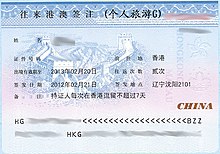| Individual Visit Scheme | |||||||||||||
|---|---|---|---|---|---|---|---|---|---|---|---|---|---|
 The Hong Kong Individual Visit Permit issued by People's Republic of China on a Chinese Two-way Permit for Hong Kong and Macau. | |||||||||||||
| Traditional Chinese | 自由行 | ||||||||||||
| Simplified Chinese | 自由行 | ||||||||||||
| Hanyu Pinyin | zì yóu xíng | ||||||||||||
| Literal meaning | free walking | ||||||||||||
| |||||||||||||
The Individual Visit Scheme (Portuguese: Visto Individual)[1] begun on 28 July 2003 allowing travelers from Mainland China to visit Hong Kong and Macau on an individual basis; prior to the Scheme, Mainland residents could only visit on business visas or on group tours.
The outbreak of SARS in Hong Kong from March to June 2003 resulted in a sharp drop in Mainland and foreign visitors to an unprecedented low, adversely affecting the tourist industry.
The main reason for launching the Individual Visit Scheme was to boost the economy of Hong Kong and Macau. In the initial stage of the scheme, residents of Beijing, Shanghai, and 8 Guangdong provincial cities (Dongguan, Foshan, Guangzhou, Huizhou, Jiangmen, Shenzhen, Zhongshan and Zhuhai) could apply for visas to visit the two 'Special Administrative Regions' individually.
The scheme was extended to all 21 cities of Guangdong province in July 2004, and to 9 other cities in Jiangsu, Zhejiang, and Fujian provinces in July 2004.[2]
The visas, issued by the Public Security Bureau of the People's Republic of China, were valid for 7 days and could be renewed upon return from Hong Kong to the Mainland.
The scheme brought an immediate surge in the number of Mainland visitors. In the short period between 28 July and 4 November 2003, more than 600,000 individuals on the Mainland applied for visas and 450,000 visas were issued. The number of visitors under the scheme reached two million by May 2004.
- ^ "Chui Sai On: ajustamento da política de visto individual tem influência positiva". Portal do Governo da RAE de Macau (in Portuguese). Gabinete de Comunicação Social. 28 May 2007. Retrieved 13 January 2024.
- ^ Press Release
